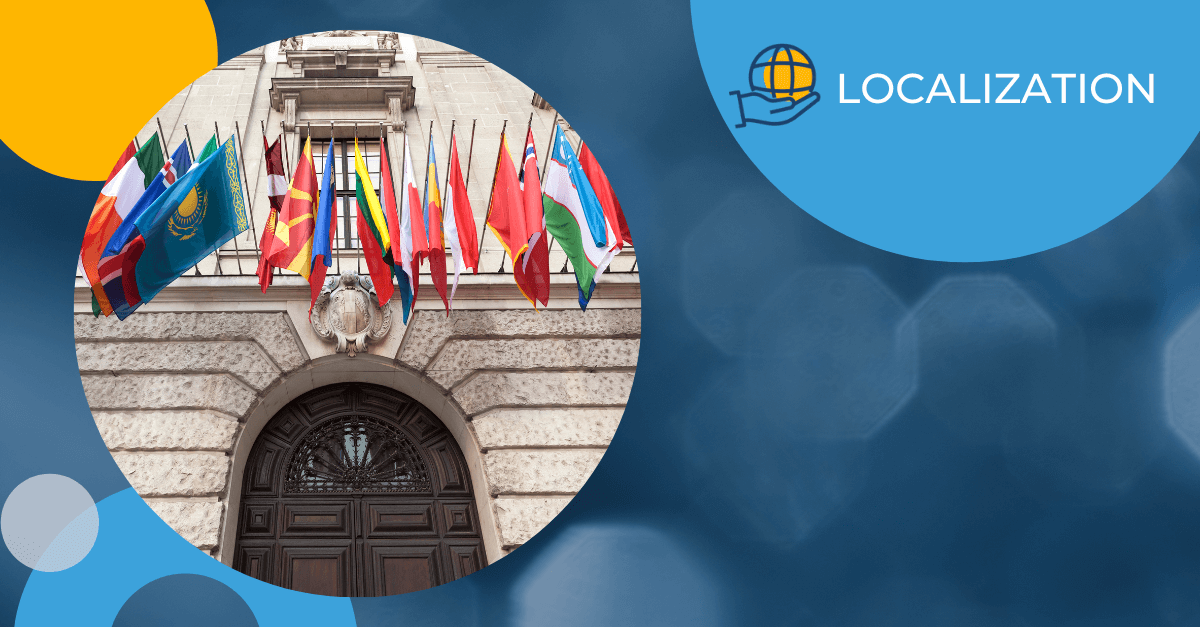Month: November 2017
Top 8 Areas for Professional Business Translation Services

If you want to successfully advertise or sell your brand in a foreign market, it helps to communicate with that new audience in their own language. However, speaking their language is not limited to verbal or written cues. It also includes taking into account cultural sensitivities and proclivities like colors, imagery, geographic references and more.
A professional translation company can help you cater your business content to make sure that you connect with as many customers as possible worldwide. Here’s how:
1. Marketing Material
Professional translations and localization of your advertising collateral, taglines, product packaging and multimedia presentations will help to promote your products and services worldwide while ensuring that what you mean to say is what is actually communicated to each distinct audience.
2. Website Translation
Allowing your customers to do business in the language they prefer is a proven way to increase interest in your products and services.
3. Desktop Publishing
Make every audience feel like the content they’re looking at was created just for them by formatting the different language versions of your website and marketing collateral to look graphically consistent across all applications.
4. Technical Documents
Ready your products for global consumption by translating product information, software manuals, operating manuals, contracts, and export and import documentation into the languages of the end users.
5. Legal Documents
Manage legal risk by obtaining 100% accurate translations of patents, court filings, discovery documents, litigation files, merger and acquisition records, and antitrust matters.
6. Financial Information
Attract new investors by providing product information, financial statements, investor relations communications, annual reports and prospectuses in multiple foreign languages.
7. Interpretation Services
Ensure complete comprehension in legal, corporate, medical and government settings with qualified and vetted interpreters who can do simultaneous, consecutive or whisper interpretation to help you communicate with ease in-person or over-the-phone.
8. Internal Documents & eLearning
Ensure all your employees, franchisees and third-party vendors fully understand your company’s policies and procedures, employee handbooks, onboarding materials, interactive eLearning programs, company announcements, and other human resources documents by providing quality translations in the local language of each office.
At Morningside Translations, we offer a full suite of translation services in over 150 languages and dialects. Our global network of 8,000+ translators (including in-country linguists) are experts in dozens of technical fields and subject areas. Contact us today to learn more about how we can help you save time and money with your business translation needs.
Get the latest insights delivered to your inbox
The Exceptional Dangers of Legal Mistranslation in China

It would be hard to find two languages more unalike than English and standard Chinese (Mandarin). Verbally, the basic sounds are completely different and the importance of pitch in Chinese has no counterpart in English. In printed documents, English words are composed of individual alphabet letters while Chinese words are represented by unique symbols in a logographic system – symbols which can be printed horizontally or vertically, depending on the location.
Despite these language hurdles, China continues to grow more and more central to global trade. At the basis of any trade deal lies a contract, and these documents are starting to get more time in the limelight. The Supreme People’s Court of China reports that from 2013 to 2015, Chinese courts resolved about 100,000 civil, commercial and maritime lawsuits involving foreign litigants – a 10.4% increase from the previous three-year period.
As the courts themselves have shown, clarity of language in business decisions has become increasingly critical in China. In this reality, having a certified interpreter and/or translator on hand for important Chinese meetings and documents is just smart business.
Advantage or disadvantage?
“He/she who controls the language can control the case,” says lawyer and Asian business expert Dan Harris, writing for China Law Blog. Legal document translations (e.g. contracts and patents) from Chinese-English or English-Chinese can put litigants at a decided advantage or disadvantage – depending on who signed off on the work.
“About 85% of the time the translation is ‘accurate’ but about 99% of the time, it has been translated in a way that favors the side doing the translation,” says Harris. For example, he explains, in some languages the same word can be translated either as ‘shall’ or as ‘should’ – two very different meanings.
Your court or mine?
Harris also makes a very important point about jurisdiction: Litigation against a China-based company outside of China is essentially useless since “most Chinese companies do not have any meaningful assets outside China and because China does not enforce foreign judgments.”
So, if you are an American company doing business in China and something goes wrong, it’s more likely than not that your lawsuit will end up before a Chinese court. If you provide that court with an English contract, the court will use its own translator to translate it into Chinese – which according to Harris means “you are not going to have any influence on what it is going to say nor will you even know what it is going to say until you have sued.”
The bottom line here is that the Chinese version of a business contract is critical to the success of future legal efforts.
The impact of translation mistakes
Translation mistakes can be so wrong as to be funny — such as when Nike printed the characters for “getting rich” and “fortune arrives” on left and right sneakers, not realizing that together they translate to “getting fat” — or even just plain silly like this can of water, but in a legal context, they’re no joke.
Qu Miao, a well-recognized litigator in Shanghai, told Lexology that in Chinese courts “the interpretation of the claim often becomes the focus of the dispute between both parties and runs through the entire trial.” This is of particular importance for patents filed in China under the Patent Cooperation Treaty (PCT) because disputes may arise over the translations of claims – and even the smallest ambiguity can cause big problems.
By small, we mean something as tiny as the letter “A.” This letter was the point of a 2014 patent infringement dispute that went all the way to the Supreme People’s Court. In Motion Fitness vs. Changzhou Yingcai Metalwork Fitness Equipment, the indefinite article “a” was translated on each instance in the Chinese version of the patent claims to “one” – a specific numerical value. This narrowed the scope of protection in the claims and wound up fatally undermining the plaintiff’s case.
Solid ground
China represents immense business opportunities for a wide variety of industries – the only catch is figuring out how to responsibly scale the gap of language and legal differences. Luckily, a highly experienced business translation service can help you “stand on solid ground,” as the Chinese proverb says. Morningside’s translators can effectively represent clients doing business in China because they are knowledgeable in Chinese law and matched on a case-by-case basis that is determined by their subject matter expertise. If documents need to be defended in a Chinese court, our top-notch interpreters can ensure that foreign-speaking legal teams remain fully informed of every utterance made in a Chinese courtroom. For more information on how we can assist with your Chinese legal translations, contact Morningside today.
Get the latest insights delivered to your inbox
Taking the Long View in Global Pharmaceutical Marketing

Ubiquitous access to the internet presents both opportunities and challenges for manufacturers of consumer-facing pharmaceutical products. On the one hand, the web offers manufacturers an exciting way to stay in touch with users across the globe — by offering ongoing product support, which if done right, helps build and maintain positive brand awareness. On the other, users have gained a virtual megaphone through which they can broadcast product critiques, and even spread potentially dangerous misinformation to other customers, patients or prospective customers/patients the world over. In both ways, effective product marketing no longer begins and ends with the sale.
The value of a strong web presence
A pharmaceutical company’s website must first and foremost be useful to customers worldwide. A well-designed, carefully and thoroughly translated online help system for each locale — including a localized searchable knowledgebase — can be the backbone of a successful post-sale pharmaceutical marketing strategy. By working with a professional life science translation service to localize online content, pharma companies gain an unprecedented chance to optimally support multiple markets and build brand loyalty in a way that would be difficult or impossible to achieve with live phone operators.
A website also offers a place to build a sense of community that supports the user experience. Pfizer’s Get Old site is an excellent example of courting customers before and after a sale. With great sensitivity to the audience’s interest and feelings — where again, a medical translator’s awareness of local attitudes is critical — the company acquires an opportunity to strategically and discreetly present customers with additional products that may address their needs.
Speed counts
It’s not just the pharma company-pharma user relationship that’s served by a website. These days, it’s quite common for a doctor or medical professional to make a quick visit to a pharma website before or during an appointment with a patient. There, they can pull up the most current product information and email or print it for the patient with the hit of a button. It’s a process that is much simpler than digging through product pamphlets or calling a manufacturer or sales rep to have questions answered.
A recent Forrester survey of U.S. online adults underscores the importance of quick access to information for users and prospective customers, in addition to medical professionals. 73% of respondents say that “valuing their time is the most important thing a company can do.” No one wants to waste time navigating through phone menus if they don’t have to.
Live chat support
While there’s likely to be a need for some level of phone support for the foreseeable future to handle a small number of unusual questions, those calls are fairly rare. For most products, localized chat support can provide a welcome alternative to phone representatives. It’s available 24/7, which removes the complication of time zones and specified support hours – and that is huge for pharmaceutical marketing strategy since, according to Forrester, 53% of potential customers will abandon a possible purchase if they can’t get the information they want immediately.
The popularity of chat as a means of communication is inarguable in any event, and the utilization of chat services for product support is growing at an estimated rate of 24% each year, says the International Customer Management Institute (ICMI). In fact, as Econsultancy has found, chat interaction results in a 73% customer satisfaction rating, as opposed to 44% for phone interaction and 61% for email response systems.
User forums
A website can also serve as a portal for local-language user forums. These are essentially multi-user chats where questions users can ask questions and the company provides answers. Near-instantaneous responses aren’t required, which makes it relatively simple to keep the conversations going while utilizing the help of the right translation company. This gives pharma companies the opportunity to address and manage any issues before they escalate – and create a sense of a personal relationship with each forum member.
Staying social
Equally important in a long-term pharmaceutical marketing plan is the need to establish and maintain an active presence on social media in each market. Facebook and Twitter are good places to start, but there are many other country-specific platforms you can use to target regionally specific customers in their own language. In China, for example, the most popular messaging app is called WeChat and it’s used by half a billion people.
A strong social media marketing presence also requires you to keep an eye on hashtags across platforms that may signify an ongoing conversation involving a company product. Partnering with a knowledgeable language services provider can be invaluable here, since nuance is everything in online discussions, and these exchanges are often based on shared cultural understandings.
Being social is ultimately a great chance to proactively engage customers and to resolve product issues before they harden into fixed “common knowledge” that damages the prospects for a product or the reputation of a company.
The longer, better endgame
Before the advent of the internet, once a product was sold, its marketing cycle was over. That’s no longer true, and while this does require a more extended strategy and prolonged attention to a product throughout its markets — and yes, more work — it also provides endless possibilities for ensuring a positive experience for customers and for establishing long-term loyalty from them. And this isn’t just a nice thing to do, either: It’s predicted that by 2020, user experience will overtake product features and price as the single most important brand differentiator. Maintaining the health of a pharmaceutical brand may depend on embracing the internet’s potential to patiently, strategically, grow your customer family.
Get the latest insights delivered to your inbox
Speaking the Language of Financial Institutions

Financial institutions take their partnerships with language services providers (LSPs) very seriously. They have to. For banks, brokerages, insurance companies, or trust companies, there is no room for errors. Turnaround times in the industry are short, transactions are often international, and accuracy is always absolutely vital – all of which require top translation companies to have a deep understanding of industry expectations, terminology and concepts.
As part of one of the largest industries worldwide, financial institutions have seen a growing need for translation services over the past decade. Between 2010 and 2011 alone, according to Common Sense Advisory, financial institutions increased their average annual translation spend by 26%. And notably, while cost is always a consideration when conducting business, in financial services it takes a back seat to other, even more pressing, requirements.
Security before everything
A 2012 report from Common Sense reveals that the single most important thing a financial institution scrutinizes when considering a translation agency is its ability to provide iron-clad security for its data. This means bullet-proof protection against online threats, including data theft and hacking. It also means that the translation service must be able to safeguard their data against natural disasters and man-made calamities. These expectations extend to any contractors or third parties working with the LSP because security must be completely air-tight at every stage of the workflow.
Accuracy has two meanings in finance
“Buyers consistently report that quality matters more to them than factors such as price,” reports Common Sense Advisory. In the context of finance, quality translations are accurate translations – and accuracy has two meanings:
- On one hand, it’s about the actual content in the source document – To translate financial content accurately, a translation company must employ linguists who are experts in finance, financial products and the financial industry style – which means being comfortable with the requisite legalese. (Note: Evidence shows that financial institutions often invest their own time to further train translators in the particulars of their own business language. It’s not uncommon for relationships to form with individual translators upon whom institutions come to rely.)
- On the other hand, it’s about the comprehension of the target audience –Financial institutions need to effectively communicate with a wide range of customers and potential customers of varying socioeconomic classes, levels of education, and familiarity with financial products and services. For international marketing materials, the goal is to make a connection with, and appeal to, customers in another culture — and this depends on the translator’s grasp of what will resonate with those people. Of course, translated materials must also comply 100% with all relevant local and regional regulations.
Interpretation is needed as much as translation
The financial industry’s dependence on language services extends beyond document translation. Live, real-time interpretation is every bit as important in an industry in which so much business is conducted face-to-face, on the phone, and in video conferences. Effective customer service — over the phone, or during loan interviews — often requires robust multilingual support as well.
Interpreters must be just as qualified as translators, being in total command of the languages spoken and equally fluent in finance. This safeguards the parties from costly, even disruptive miscommunications, especially during sensitive negotiations. In addition to linguistic mastery, an interpreter must have the deep cultural knowledge that allows the faithful rendering of each spoken nuance.
Challenges exist to be met
In today’s globalized economy, every financial institution – regardless of its size – needs to communicate effectively with speakers of other languages, locally and across the world. Finding the right language service provider to assist with that is a big decision. At Morningside Translations, we guarantee iron-clad security and reliable accuracy with an expansive worldwide network of expert linguists versed both in the intricacies of finance and in the local cultures they serve.
Get the latest insights delivered to your inbox
HTML5: How a Developer’s Dream Turned into a Localization Engineer’s Good Fortune

Last month, the newest HTML standard from the World Wide Web Consortium (W3C) officially turned three years old. However, in a trend similar to most programming languages or front-end frameworks, HTML5 is only now starting to get the global use it deserves.
Its release three years ago sparked the usual curiosity from UX designers and web programmers, but now the development community is not the only audience excited about HTML5’s capabilities. Business analysts, small business owners, localization engineers, social media marketers, and search engine optimizers are all admitting that their companies are making great strides to become HTML5 compliant.
The release of this new “Living Standard,” as many are calling, has made content localization incredibly easy and immensely flexible for both creators and consumers on the web.
Keep it simple
The most brilliant aspect of this move by W3C is its simplicity – technical updates are brief, intuitive and powerful. Sites that leverage HTML5 are now free from worrying over the differences between devices, browsers and the content the site itself owns. For the first time in web history, HTML markup itself can handle a shift between mobile and desktop without the aid of a larger styling framework like Bootstrap to handle the legwork.
Beyond that, HTML5 introduced a rich and robust API for natively hosting playback for video, audio content and vector-graphic animation in a site’s static code. By now, it’s not exactly news that HTML5 was the final nail in Flash’s coffin. The technical benefits, however, are just the tip of the iceberg.
New elements
Most aspects of the new standard that appeal to global content creators are primarily simple additions to the markup language’s element and attribute library. HTML5 offers new tags that allow for a logical organization of content based on type. For example, an entire block of elements dedicated to blogs and articles was given support.
Content creators now have a slew of native HTML elements to choose from to organize posts or informative pages within their domain. The gist of the elements <article/>, <section/>, <header/> and <footer/> is still simply a method of storing plain text in a document, but with better out-of-the-box styling and the ability to localize more effectively as compared to <span/> and <p/>. A developer may work with their business team to build requirements around placing all translatable content in <article/> elements, for instance. Other examples of elements that display HTML5’s modularity are <summary/>, <section/> and <description/>, whose purposes are fairly self-explanatory.
Attributes
The only ironic part about adding new element sets to allow for content encapsulation is that a smaller component of the markup – attributes – is proving to be more powerful for people worrying about localization. Attributes now allow for any element that houses text to be tagged to identify:
- the source language of the text
- whether or not it contains a term that should be translated
- the intended directionality of the text.
While new modular element sets may help with organization, attributes such as these allow for both increased developer freedom and seamless localization capabilities.
Translation just got a whole lot easier
The concept of if a particular text block should be translated is huge; now the parsing engines of translation services can get by with filtering markup on one of two attributes: translate and its-term. The former’s purpose is to indicate if a medium-to-large body of text requires translation, and the latter is for indicating terminology definitions within a body of text.
The lang attribute is another simple addition that allows for indicating which source language is contained in an element. Pairing lang with the dir attribute has the potential to leave zero gaps in requirements when a content creator approaches a vendor for localization. The dir attribute, standing for “directionality,” explains whether the source language is right-to-left or vice versa.
A perhaps less obviously named, but just as powerful feature that appeared with HTML5 is the ruby annotation. The elements that the ruby annotation is comprised of allow for specifying the pronunciation of the text the annotation encapsulates. While this is applicable to all languages, it marks the first time that Asian languages have the web support for full coverage of their metadata. Gone are the days of “difficult languages” when performing localization and desktop publishing on web content.
A tool of revolution
HTML5 is the small and clairvoyant technical change that allowed for a huge step in the right direction in terms of globalizing web content. Beyond being a sturdy addition to a crucial software construct, it has already acted as a tool of revolution in the way companies think of their presence on the Web. Hopefully, over the next three years we will see the frameworks that are leveraging its sleek and lucid API make it easier for brilliant business minds to reach a wider audience with more accurate localization capabilities.

